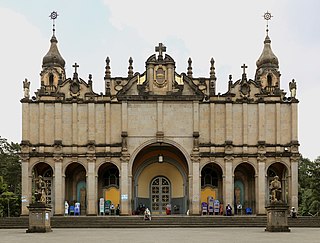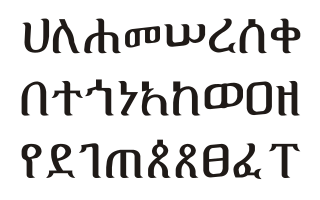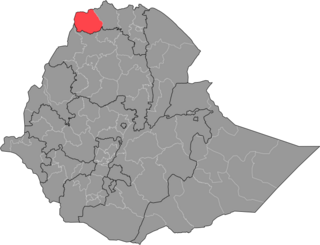Related Research Articles

The Ethiopian Orthodox Tewahedo Church is the largest of the Oriental Orthodox Churches. One of the few Christian churches in sub-Saharan Africa originating before European colonization of the continent, the Ethiopian Orthodox Tewahedo Church dates back centuries, and has a current membership of about 36 million people, the majority of whom live in Ethiopia. It is a founding member of the World Council of Churches. The Ethiopian Orthodox Tewahedo Church is in communion with the other Oriental Orthodox churches.

P'ent'ay is an originally Amharic–Tigrinya language term for Pentecostal and other Eastern-oriented Protestants within Ethiopia and Eritrea, and the Ethiopian and Eritrean diaspora. Today, the term refers to all Evangelical Protestant denominations and organisations in Ethiopian and Eritrean societies as Ethiopian–Eritrean Evangelicalism or the Ethiopian–Eritrean Evangelical Church. Sometimes the denominations and organizations are also known as Wenigēlawī.

Weldiya or Woldia is a town, woreda, and capital of the North Wollo Zone in northern Ethiopia. Located north of Dessie and southeast of Lalibela in the Amhara Region, this town has an elevation of 2112 meters above sea level.

Kombolcha is a town and district in north-central Ethiopia. Located in the Debub Wollo Zone of the Amhara Region, it has a latitude and longitude of 11°5′N39°44′E with an elevation between 1842 and 1915 meters above sea level. Some guide books describe Kombolcha as the twin town of Dessie which lies some 12 kilometres (7.5 mi) to the northwest.

Habesha peoples is an ethnic or pan-ethnic identifier that has been historically employed to refer to Semitic language-speaking and predominantly Orthodox Christian peoples found in the highlands of Ethiopia and Eritrea between Asmara and Addis Ababa and this usage remains common today. The term is also used in varying degrees of inclusion and exclusion of other groups.

Geʽez is a script used as an abugida (alphasyllabary) for several Afro-Asiatic and Nilo-Saharan languages of Ethiopia and Eritrea in the Horn of Africa. It originated as an abjad and was first used to write the Geʽez language, now the liturgical language of the Ethiopian Orthodox Tewahedo Church, the Eritrean Orthodox Tewahedo Church, the Eritrean Catholic Church, the Ethiopian Catholic Church, and Haymanot Judaism of the Beta Israel Jewish community in Ethiopia. In the languages Amharic and Tigrinya, the script is often called fidäl (ፊደል), meaning “script” or “letter”. Under the Unicode Standard and ISO 15924, it is defined as Ethiopic text.

Tigray Province, also known as Tigre, was a historical province of northern Ethiopia that overlayed the present day Afar and Tigray regions. It encompassed most of the territories of Tigrinya-speakers in Ethiopia. Tigray was separated from the northern Tigrinya speaking territories by the Mareb River, now serving as the state border to Eritrea, with the Tekezé River separating it from the Amhara dominated south.

The Western Zone is a zone in the Tigray Region of Ethiopia. It is subdivided into three woredas (districts); from north to south they are Kafta Humera, Welkait and Tsegede. The largest town is Humera. The Western Zone is bordered on the east by the North Western Zone, the south by the Amhara Region, the west by Sudan and on the north by Eritrea.

Tigrayans are Semitic-speaking ethnic group indigenous to the Tigray Region of northern Ethiopia. They speak the Tigrinya language, an Afroasiatic language belonging to the Ethiopian Semitic branch.

The Southern Zone is a zone in the Tigray Region of Ethiopia. The Southern Zone is bordered on the south and west by the Amhara Region, on the north by the Central Zone, and on the east by the Afar Region. Towns and cities in the Southern Zone include Maychew, Korem, and Alamata. The South Eastern Zone was separated from the Southern Zone.

The Ethiopian Catholic Church is a metropolitan sui iuris Eastern particular church within the Catholic Church, established in 1930 in Ethiopia.

Kahen is a religious role in Beta Israel second only to the monk or falasyan. Their duty is to maintain and preserve the Haymanot among the people. This has become more difficult by the people's encounter with the modernity of Israel, where most of the Ethiopian Jewish people now live.

The Welayta, Wolayta or Wolaitta are an ethnic group and its former kingdom, located in southern Ethiopia. According to the most recent estimate (2017), the people of Wolayta numbered 5.83 million in Welayta Zone. The language of the Wolayta people, similarly called Wolaytta, belongs to the Omotic branch of the Afro-Asiatic language family. Despite their small population, Wolayta people have widely influenced national music, dance and cuisine in Ethiopia.

Religion in Ethiopia consists of a number of faiths. Among these mainly Abrahamic religions, the most numerous is Christianity totaling at 67.3%, followed by Islam at 31.3%. There is also a longstanding but small Jewish community. Some adherents of the Baháʼí Faith likewise exist in a number of urban and rural areas. Additionally, there is also a substantial population of the adherents of traditional faiths.
Articles related to Ethiopia include:

Religion in Eritrea mainly consists of Abrahamic faiths. Since May 2002, the Eritrean government has officially recognized the Eritrean Orthodox Tewahedo Church, the Eritrean Catholic Church, the Evangelical Lutheran Church of Eritrea, and Sunni Islam. All other faiths and denominations are in principle required to undergo a registration process; in practice they are not allowed to register. Among other things, the government's registration system requires religious groups to submit personal information on their membership to be allowed to worship.
Karl Wilhelm Isenberg, spelt or known by names Carl Wilhelm Isenberg or Charles William Isenberg or C. W. Isenberg or Carl W. Isenberg or Charles Isenberg, was a German Church Missionary Society missionary and linguist to East Africa and Western India.

The North Western Zone is a zone in Tigray Region of Ethiopia. It is bordered on the east by the Central Zone, the south by the Amhara Region, the west by the Western Zone and on the north by Eritrea. The Zone is subdivided into the six woredas (districts), which are Asigede Tsimbela, La'ilay Adiyabo, Medebay Zana, Tahtay Adiyabo, Tahtay Koraro and Tselemti. Major towns and cities in the zone include Shire, Sheraro, Inda Aba Guna, Selekleka, Adi Daero, May Tsebri. The North Western Zone was split off from Western Zone in 2005.
Anuak Zone or Anywaa Zone is a zone in Gambela Region of Ethiopia. It was created from former Administrative Zone 1 and Administrative Zone 2 of Gambela. This zone is bordered on the southwest by South Sudan, on the southeast by the Southern Nations, Nationalities, and Peoples Region, on the east by Majang Zone, on the northeast by the Oromia Region, and on the northwest by South Sudan and Nuer Zone. Towns in this zone include Gambela, Abobo and Pinyudo.

The Ethiopian traditional educational system traced back to Axumite period in 330 AD as Christianity first accepted in the region. The education was highly emphasized Christian dogma, consisted up to higher education, the monastery. Students graduated from every monasteries earn ranks of priesthood and upon reaching the final stage, the Negus, they acquire an intellectual elite, known as debtera.
References
- Wondiye Ali, Awakening at Midnight: the story of the Kale Heywet Church in Ethiopia Vol. 2, 1942-1973 (Amharic), published by the KHC Literature Department, Addis Ababa, 2000.
- Johnny Bakke, Christian Ministry Patterns and Functions within the Ethiopian Evangelical Church Mekane Yesus (New Jersey: Humanities Press, 1987).
- E. Paul Balisky, "Wolaitta Evangelists: A Study of Religious Innovation in Southern Ethiopia, 1936-1975", (PhD thesis, University of Aberdeen, 1997).
- Aaron Belz, "A Leopard among the Bannas: Mahay Choramo Faced down Hardship and Violent Opposition to Minister to the Murderous Nomads of Ethiopia's Southern Frontier", Christian History (August 2003)
- Albert E. Brant, In the Wake of Martyrs (Langley, B.C.: Omega Publications, 1992).
- Edith Buxton, Reluctant Missionary (London: Hodder & Stoughton, 1968).
- Mahari Choramo, Ethiopian Evangelist: Autobiography of Evangelist Mahari Choramo, annotated by Brian L. Fargher, (Edmonton: Enterprise Publications, 1997).
- F. Peter Cotterell, Born at Midnight (Chicago: Moody Press, 1973).
- F. Peter Cotterell, Cry Ethiopia (Eastbourne: MARCO, 1988).
- Raymond Davis, Fire on the Mountain (New York/Toronto: SIM, 1966).
- Raymond Davis, Winds of God (Canada: SIM International Publications, 1984).
- Clarence W. Duff, Cords of Love. A Pioneer Mission in Ethiopia (Phillipsburg, N.J.: Presbyterian & Reformed Publishing Co., 1980).
- Brian L. Fargher, The New Churches Movement in Ethiopia 1928-1944 (E.J. Brill, 1998).
- Brian L. Fargher, "The Origins of the New Churches Movement in the Hammer Bako Area 1954- 1961", unpublished MS by Brian Fargher with Donald and Christine Gray (March 1996).
- W. Harold Fuller, Run While the Sun is Hot (Chicago: Moody, 1967).
- Norman Grubb, Alfred Buxton of Abyssinia & Congo (London & Redhill: Lutterworth Press, 1942).
- Lucy Winifred Horn, Hearth and Home in Ethiopia (London: SIM, 1960).
- Thomas A. Lambie, A Doctor without a Country (London: Fleming & Revell Company, 1939).
- Guy W. Playfair, Trials and Triumphs in Ethiopia (Toronto, Canada: SIM, undated, ca. 1943).
- A. G. H. Quinton, Ethiopia and the Evangel (London: Marshall, Morgan & Scott, 1949).
- Ed & Edna Ratzliff, Letters from the Uttermost Parts of the Earth (Privately published, 1987).
- Alfred G. Roke, An Indigenous Church in Action (Auckland, N.Z.: Sudan Interior Mission, 1938).
- J. Spencer Trimingham, The Christian Church and Missions in Ethiopia (World Dominion Press, 1950).
Specific
- ↑ "Choramo, Mahay (A)". Dictionary of African Christian Biography. Retrieved 18 August 2019.